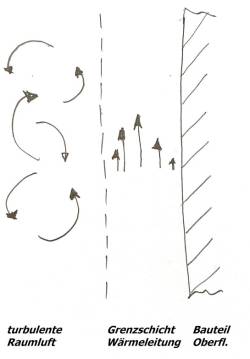Heat transfer I
In practical building physics, reservoirs are often heated (or cooled) spaces and their temperatures are characterised by the “indoor air temperature” 1) . However, for a first approximation, the indoor air temperatures are not so bad at all, especially if the building is relatively well-built with regard to thermal characteristics, because these temperatures will then barely differ from the operative temperature (most of the time).
 If air is present in spaces with a diameter 2) of more than a few centimetres at normal room temperatures, then turbulent air movement will always be present inside the space. Even if the respective air velocities are small 3) , this will lead to strong mixing of the air in the occupied area; this is referred to as complete/homogeneous mixing. For this reason, the air temperatures in the occupied space are virtually constant because differences are always equalised quite fast due to convection.
If air is present in spaces with a diameter 2) of more than a few centimetres at normal room temperatures, then turbulent air movement will always be present inside the space. Even if the respective air velocities are small 3) , this will lead to strong mixing of the air in the occupied area; this is referred to as complete/homogeneous mixing. For this reason, the air temperatures in the occupied space are virtually constant because differences are always equalised quite fast due to convection.
In practice: convective turbulent flow in thick air layers is also the reason why the air in the room has virtually no insulating effect. If there was, then we humans would have considerable problems with releasing the heat generated by our bodies/us. For the same reason, with increases in the thickness beyond approximately 16 mm the insulating effect of an air layer hardly improves any further; here too, the heat is then transferred in the air mainly by convection. This gives us a new perspective on the mode of action of conventional insulation materials: these are basically just packaged air; air which is prevented from strong convective-turbulent mixing and therefore has a good heat insulating effect. Permanent turbulent convection in the room is also the reason why odours, light dust particles and also microbes can spread relatively quickly over an entire room. A few minutes are enough for the smell or microbes to disperse practically everywhere in the room.
Now if we are near a surface, the air can only exhibit low velocities here which are only parallel to the surface 4) . At the surface there is an area with air that is almost still or flowing only parallel to the surface 5) . Due to this layer, heat again can only be transported via heat conduction 6) , so we have an additional thermally insulating air layer on every surface which is also called the “boundary layer” or “heat transfer layer”. In the construction sector, this layer thickness is only 1 to 2 cm, so the insulation effect produced here is very small. Knowing this “heat transfer resistance” $R_i$ and $R_e$ is important mainly because due to its existence the temperature at the surfaces differs somewhat 7) compared to that of the air; this may lead to problems particularly with poorly insulated building assemblies. Here the subscript i stands for “internal”, e stands for “external”(outside). Heat transport due to radiation is also added for initial approximate consideration 8) . In addition, it is established practice to assume constant values for these heat transfers 9) . Thus, this is even specified in norms for the 'official' U-values and the following values are common for this.
| Oberflächensituation | $R_{surface}$ | $h_{surface} = \frac {1}{R_{surface}}$ | |
|---|---|---|---|
| m²K/W | W/(m²K) | ||
|---|---|---|---|
| internal | vertical | 0.13 | 7.7 |
| “downwards” | 0.17 | 5.9 | |
| “upwards” | 0.1 | 10 | |
| external | wind and weather | 0.04 | 25 |
To illustrate the application: we will consider a simple 4 mm thick vertical glass pane (in the dark 
${\displaystyle R_g = R_i + \frac {d}{\lambda} + R_e = 0,13 \text{ m²K/W} + \frac {0,004 \text{ m} }{1 \text{ W/(mK)} } + 0,04 \text{ m²K/W} = 0,174 \text{ m²K/W}}$
 In this way we have determined the heat transfer resistance of single-glazing consistent with the table in the section on U-values. The U-value is therefore
In this way we have determined the heat transfer resistance of single-glazing consistent with the table in the section on U-values. The U-value is therefore
${\displaystyle U_g = \frac {1}{R_g} = 5,7 \text{ W/(m²K)} .}$
The insulating effect of single-glazing consists virtually only of the internal heat transfer resistance. The consequences of this are extremely high heat loss and an extremely cold interior surface temperature at the glass surface; this may even be lower than freezing point, leading to frost patterns.
Exercise: You can recalculate all the U-values given in the table in the section on U-values. Any thermal conductivities which may not be mentioned here for some materials in the table can easily be found on the Internet. If thicknesses are not given, check whether the necessary thicknesses are within a plausible range.
Go to overview of thermal radiation 🌡️
Back to section on U-value of a multilayer build-up 🌡️
Back to section on thermal conductivity 🌡️
Back to the Building Physics Basic Course - Heat - Overview 🌡️
